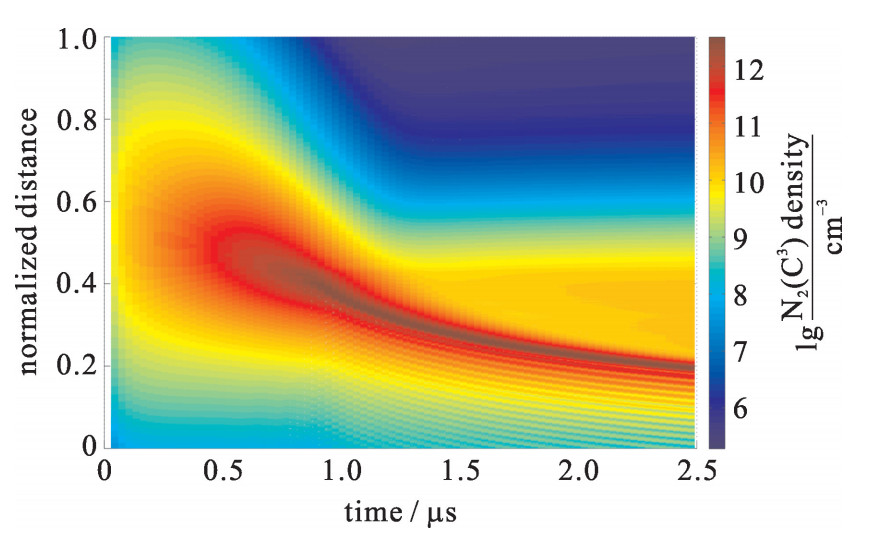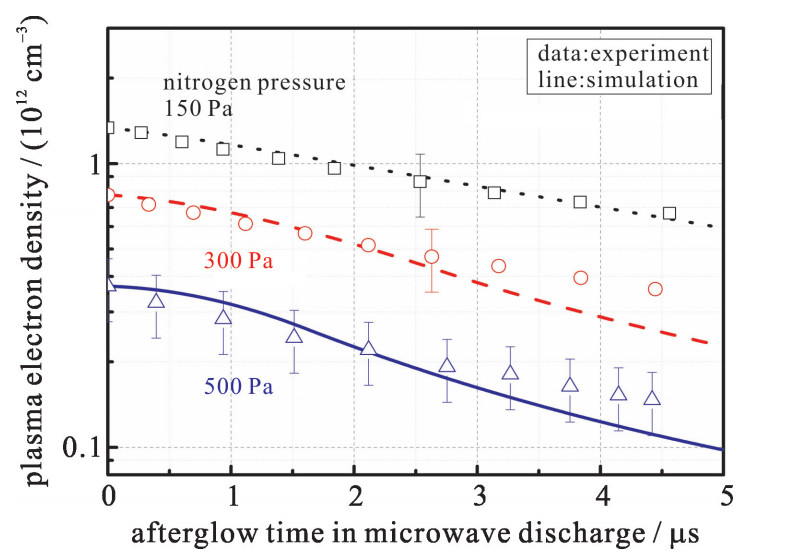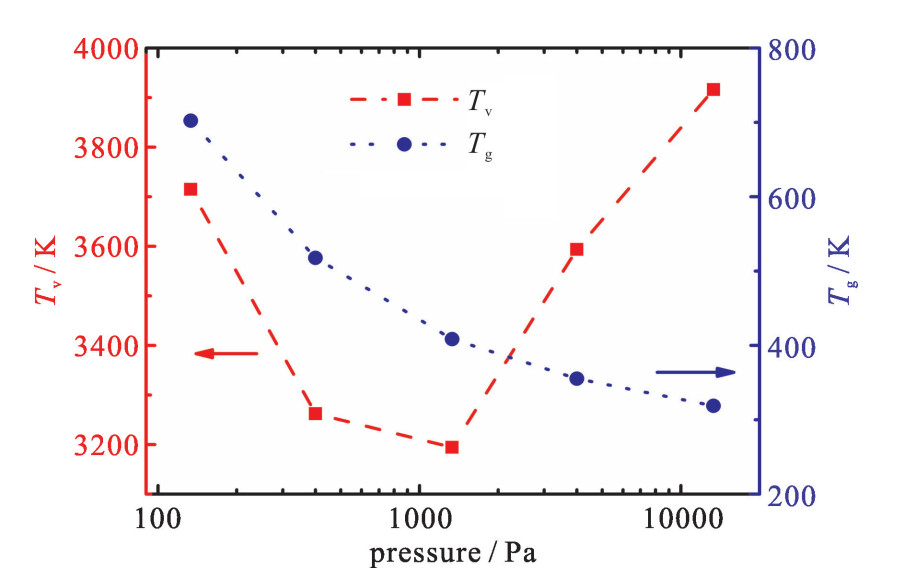Kinetic study on microwave discharge plasma and its afterglow
-
摘要: 研究了微秒脉冲聚焦微波束气体放电等离子体的动理学过程。数值模型基于自洽求解的微波电场亥姆霍兹方程、粒子连续性方程以及电子能量、气体分子振动能量和平动能量的平衡方程,并与等离子体动理学反应互相耦合。对比了国外报道的近期两项相关实验:次MW级X波段9.4 GHz微波氮气击穿和MW级W波段110 GHz微波大气击穿。在次MW级实验中,计算所得电子激发态N2(C3Πu)的数密度与实验所测发射光谱第二正带隙的强度一致;在MW级实验中,模拟结果重复了发射光谱测量所得振动温度和平动温度对放电气压的依赖关系。结果揭示了上述模拟和实验符合的内在物理机制。Abstract: Gas discharge plasmas generated by μs-pulse focused microwaves are investigated. The model is based on a self-consistent solution to Helmholtz equation for microwave field, particle continuity equations, and the energy balance equations, coupled with plasma kinetics. Two recent experiments are studied: a. sub-megawatt (MW) X-band 9.4 GHz microwave breakdown in nitrogen; b. MW-class W-band 110 GHz microwave breakdown in 100-10 000 Pa air. In experiment a, the tracked density of electronic states N2(C3Πu) agreed with the measured intensity from second positive system (SPS) of optical emission spectroscopy (OES). In experiment b, the simulation results reproduced the dependence of nitrogen vibrational and translational temperature on air pressure measured by OES. The underlying mechanisms for the above coincidences are unveiled.
-
Key words:
- high power microwave /
- gas discharge /
- plasma /
- energy balance /
- optical emission spectroscopy
-
表 1 氮气等离子体中简化的反应过程
Table 1. Reduced reaction set of nitrogen plasma used in model
No. of reactions reaction rate constant reference E1 electron elastic collisions (momentum transfer)
e+N2⇔e+N2
excitation of rotational levels
e+N2⇔e+N2(rot)
excitation\de-excitation of vibrational levels
e+N2⇔e+N2(X1Σg, v=0~8)
excitation of electronic levels
e+N2⇔e+N2(A3, B3, A′1, C3)
electron impact ionization
e+N2⇔e+e+N2+rate constant (cm3·s-1)
calculated from cross section
σ by Bolsig+[12] Q2 quenching of electronic states
N2(B3)+N2⇔N2(A3)+N23×10-11 cm3·s-1 [13] Q3 N2(A3)+N2⇔N2+N2 3×10-16 cm3·s-1 [13] Q4 N2(A′1)+N2⇔N2(B3)+N2 1.9×10-13 cm3·s-1 [13] Q5 N2(C3)+N2⇔N2(B3)+N2 10-11 cm3·s-1 [14] Q6 N2(C3)+N2⇔N2(A′1)+N2 10-11 cm3·s-1 [13] O7 optical transition*
N2(C3)⇔N2(B3)+hν1.39×107 s-1 [15] O8 N2(B3)⇔N2(A3)+hν 1.35×105 s-1 [13] P9 pooling reaction
N2(A3)+N2(A3)⇔N2(B3)+N23×10-10 cm3·s-1 [13] P10 N2(A3)+N2(A3)⇔N2(C3)+N2 1.5×10-10 cm3·s-1 [14] C11 charged particle reaction
N2(A3)+N2+⇔N3++N3×10-10 cm3·s-1 [16] C12 2N2+N2+⇔N4++N2 8.5×10-29 cm6·s-1 [17] C13 N4++N2⇔2N2+N2+ 2.1×10-16exp(Tg/121) cm3·s-1 [13] C14 N4++e⇔N2+N2(C3) 2.6×10-6(300/Te)0.53 cm3·s-1 [18] C15 N2++e⇔N+N 1.8×10-7(300/Te)0.39 cm3·s-1 [18] *Optical transitions from other electronic states with longer lifetime are neglected.
Electron temperature and gas temperature are in units of Kelvin.
For a complete air plasma chemistry, the readers may refer to our previous paper[19]. -
[1] Oda Y, Komurasaki K, Takahashi K, et al. Plasma generation using high-power millimeter-wave beam and its application for thrust generation[J]. J Appl Phys, 2006, 100: 113307. doi: 10.1063/1.2399899 [2] Granatstein V L, Nusinovich G S. Detecting excess ionizing radiation by electromagnetic breakdown of air[J]. J Appl Phys, 2010, 108: 063304. doi: 10.1063/1.3484044 [3] Imai T, Kobayashi N, Temkin R, et al. ITER R&D: Auxiliary systems: Electron cyclotron heating and current drive system[J]. Fusion Eng Des, 2001, 55: 281-289. doi: 10.1016/S0920-3796(01)00203-4 [4] Hidaka Y, Choi E M, Mastovsky I, et al. Observation of large arrays of plasma filaments in air breakdown by 1.5-MW 110-GHz gyrotron pulses[J]. Phys Rev Lett, 2008, 100: 035003. doi: 10.1103/PhysRevLett.100.035003 [5] Mesko M, Bonaventura Z, Vasina P, et al. An experimental study of high power microwave pulsed discharge in nitrogen[J]. Plasma Sources Sci Technol, 2006, 15: 574-581. doi: 10.1088/0963-0252/15/3/037 [6] Bonaventura Z, Trunec D, Mesko M, et al. Self-consistent spatio-temporal simulation of pulsed microwave discharge[J]. J Phys D: Appl Phys, 2008, 41: 015210. doi: 10.1088/0022-3727/41/1/015210 [7] Nam S K, Verboncoeur J P. Theory of filamentary plasma array formation in microwave breakdown at near-atmospheric pressure[J]. Phys Rev Lett, 2009, 103: 055004. doi: 10.1103/PhysRevLett.103.055004 [8] Boeuf J P, Chaudhury B, Zhu G. Theory and modeling of self-organization and propagation of filamentary plasma arrays in microwave breakdown at atmospheric pressure[J]. Phys Rev Lett, 2010, 104: 015002. doi: 10.1103/PhysRevLett.104.015002 [9] Zhou Qianhong, Dong Zhiwei. Modeling study on pressure dependence of plasma structure and formation in 110 GHz microwave air breakdown[J]. Appl Phys Lett, 2011, 98: 161504. doi: 10.1063/1.3583452 [10] Semenov V E, Rakova E I, Glyavin M Y, et al. Breakdown simulations in a focused microwave beam with the simplified model[J]. Phys Plasma, 2016, 23: 073109. doi: 10.1063/1.4958313 [11] Hagelaar G J M, Pitchford L C. Solving the Boltzmann equation to obtain electron transport coefficients and rate coefficients for fluid models[J]. Plasma Sources Sci Technol, 2005, 14 (4): 722. doi: 10.1088/0963-0252/14/4/011 [12] Phelps A V, Pitchford L C. Anisotropic scattering of electron by N2 and its effect on electron transport[J]. Phy Rev A, 1985, 31: 2932. doi: 10.1103/PhysRevA.31.2932 [13] Capitelli M, Ferreira C M, Gordiets B F, et al. Plasma kinetics in atmospheric gases[M]. New York: Springer-Verlag, 2000. [14] Popov N A. Fast gas heating in a nitrogen-oxygen discharge plasma: Ⅰ. Kinetic mechanism[J]. J Phys D: Appl Phys, 2011, 44: 285201. doi: 10.1088/0022-3727/44/28/285201 [15] Kimura T, Akatsuka K, Ohe K. Experimental and theoretical investigations of DC glow discharges in argon-nitrogen mixtures[J]. J Phys D: Appl Phys, 1994, 27: 1664-1671. doi: 10.1088/0022-3727/27/8/013 [16] Kossyi I A, Kostinsky A Y, Matveyev A A, et al. Kinetic scheme of the non-equilibrium discharge in nitrogen-oxygen mixtures[J]. Plasma Sources Sci Technol, 1992, 1(3): 207. doi: 10.1088/0963-0252/1/3/011 [17] Aleksandrov N L, Kindysheva S V, Kirpichnikov A A, et al. Plasma decay in N2, CO2 and H2O excited by high-voltage nanosecond discharge[J]. J Phys D: Appl Phys, 2007, 40: 4493-4502. doi: 10.1088/0022-3727/40/15/019 [18] Florescu-Mitchell A I, Mitchell J B A. Dissociative recombination[J]. Phys Rep, 2006, 430: 277-374. doi: 10.1016/j.physrep.2006.04.002 [19] Yang Wei, Zhou Qianhong, Dong Zhiwei. Simulation study on nitrogen vibrational kinetics in a single nanosecond pulse high voltage air discharge[J]. AIP Adv, 2016, 6: 055209. doi: 10.1063/1.4950797 [20] 朱国强, Boeuf J P, 李进贤. 压强与功率对高气压空气微波放电自组织结构影响的数值研究[J]. 物理学报2012, 23: 235202. doi: 10.7498/aps.61.235202Zhu Guoqiang, Boeuf J P, Li Jinxian. Effects of pressure and incident power on self-organization pattern structure during microwave breakdown in high pressure air. Acta Physica Sinica, 2012, 23: 235202 doi: 10.7498/aps.61.235202 [21] Yang Wei, Zhou Qianhong, Dong Zhiwei. Kinetic study on gas discharge plasma generated by focused microwaves[C]//Proc 33rd International Conference on Phenomena in Ionized Gases. 2017: 59. [22] Mesko M, Bonaventura Z, Vasina P, et al. Electron density measurements in afterglow of high power pulsed microwave discharge[J]. Plasma Sources Sci Technol, 2004, 13: 562-568. doi: 10.1088/0963-0252/13/4/002 [23] Yang Wei, Zhou Qianhong, Dong Zhiwei. Kinetic study on non-thermal volumetric plasma decay in the early afterglow of air discharge generated by a short pulse microwave or laser[J]. J Appl Phys, 2016, 120: 083302. doi: 10.1063/1.4961951 [24] Hummelt J S, Shapiro M A, Temkin R J. Spectroscopic temperature measurements of air breakdown plasma using a 110 GHz megawatt gyrotron beam[J]. Phys Plasmas, 2012, 19: 123509. doi: 10.1063/1.4773037 [25] 石宝凤, 林文斌, 赵朋程, 等. 等效电离参数对110 GHz高功率微波放电离子体的影响[J]. 中国科学: 物理学力学天文学, 2015, 45: 025201. https://www.cnki.com.cn/Article/CJFDTOTAL-JGXK201502008.htmShi Baofeng, Lin Wenbin, Zhao Pengcheng, et al. Effect of effective ionization parameters on the 110 GHz high-power microwave discharge plasma in air. Sci Sin-Phys Mech Astron, 2015, 45: 025201 https://www.cnki.com.cn/Article/CJFDTOTAL-JGXK201502008.htm [26] Yang Wei, Zhou Qianhong, Dong Zhiwei. Simulation study on nitrogen vibrational and translational temperature in air breakdown plasma generated by 110 GHz focused microwave pulse[J]. Phys Plasmas, 2017, 24: 013111. doi: 10.1063/1.4974161 [27] Yang Wei, Dong Zhiwei. Electron-vibrational energy exchange in nitrogen-containing plasma: a comparison between an analytical approach and a kinetic model[J]. Plasma Sci Technol, 2016, 18(1): 12-16. doi: 10.1088/1009-0630/18/1/03 [28] 蔡北兵, 余道杰, 周东方, 等. 氧负离子解吸附过程HPM大气击穿弛豫时间分析[J]. 强激光与粒子束, 2017, 29: 113004. doi: 10.11884/HPLPB201729.170265Cai Beibing, Yu Daojie, Zhou Dongfang, et al. Analysis of air breakdown relaxation time of high power microwave based on O- detachment. High Power Laser and Particle Beams, 2017, 29: 113004 doi: 10.11884/HPLPB201729.170265 -





 下载:
下载:



